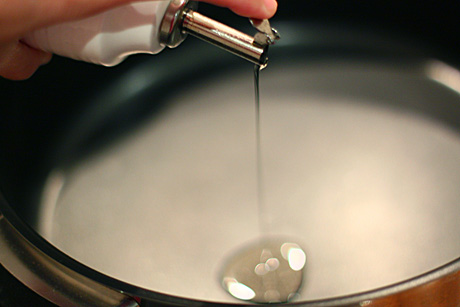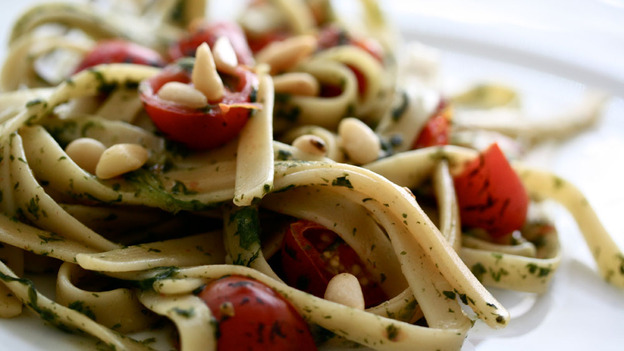Beginning cooks often feel they have to follow a recipe to the letter. It’s as if these guides are somehow sacrosanct and cannot be changed. It’s as if we dare not trust our own instincts or that we’re afraid to taste something while it’s cooking. Nonsense!
Recipes are just a guideline for real cooks. Have you seen any of the cooking contest shows on television? Often the chefs are given a series of ingredients and they have to figure out how to create something from those ingredients without any recipe or reference. It’s one of the measures of good cooks. After all, recipes have to come from somewhere.
We have been brainwashed into believing we need these formulas to create a dish we like. When I create something others like, they often ask for the recipe. But I don’t always have one. I often make stuff up as I go. Also, I rarely follow a recipe to the letter. The only exception, usually, is baking. There’s a lot of science in baking and so until you get really good at it, it’s best to follow the instructions exactly.
I’ll give you a perfect example. Chicken thighs were on sale, in three-pound packages, at the store this week. So, I had to come up with a good way to use them. I looked through my recipes and came up with a dish of chicken, pasta, cherry tomatoes and feta cheese that I had made before with success.
But I still added some things to the dish that the recipe didn’t call for. And that’s okay. It still came out great and we all had seconds.
First, I put a stockpot (with the lid on) two-thirds full of water on the stove on medium-low to heat up. Why such a low temperature? Because it would be a little while before I would be cooking the pasta, but I didn’t want to wait when the time came to do it. All I would have to do is crank up the heat a few minutes before I put the pasta in.
Next, I put my everyday pan, a two-handled bowl-shaped skillet, on low heat while I cleaned the chicken thighs. I always wash all meat, fruit and vegetables before I do anything with them. The prevalence of chemical fertilizers, pesticides, manure and just plain dirt means washing is a must, even if it was washed during processing. After all, it can’t hurt.
I trimmed fat and excess skin from the chicken pieces and laid them out on paper towels to dry. I covered the pieces with more paper towels to dry off the top sides. I left some of the skin on because it would add a great deal of flavor to the chicken. It was important to dry the pieces because I was going to fry them in a little olive oil. Wet food and hot oil don’t mix and can be quite dangerous, causing burns and even fires.
Before cooking the chicken, I put a little salt, lemon pepper, Mrs. Dash (I love these spice combinations) and paprika over one side of the chicken. I kept the spices nearby so I could season the other side once the pieces were in the pan.
Now that the pan was hot, I added a couple tablespoons of extra virgin olive oil. In the past, I would have used canola oil for this, but I’m tired of that fishy smell canola oil gets when really hot. So, I’m using canola oil less and less. Next time, I’ll be buying safflower oil as my regular oil. Using extra virgin olive oil meant keeping the heat low. But that’s okay because I prefer to cook meat at a lower temperature for a longer time. I think it gets the meat to a safe temperature better without burning or turning the meat tough.
There were eight pieces of chicken but only four would fit into the pan at a time, so I would have to do two batches. The recipe called for two chicken breast halves, so I figured three thighs would yield the same amount of meat. Also, I knew I would have to let the chicken I was using cool a bit since I would have to pull the meat from the bones.
Almost immediately after putting the chicken in the hot oil, I used my tongs to move the pieces around a little. This helps keep them from sticking. My pan is not non-stick. Every few minutes, I turn the pieces around. When browned on one side I turn them over. I set up a plate with newspaper on it to take the pieces when they were done.
Meanwhile, I halved the cherry tomatoes and got the colander, two bowls and dried herbs ready. Next I cranked up the heat on the pasta pot. I had two bowls ready because I would need one to catch the pasta water, part of which would go back into the dish. The other would be for the dish itself.
I set three finished pieces of chicken aside to cool to add to the dish. I tented the plate with newspaper with foil (in part to keep the cat off the chicken). When the water was at a rolling boil, I added several good pinches of kosher salt and then broke up spaghetti to put in the water. The recipe had called for rotini, but all I had was several boxes of spaghetti, so it would have to do.
When the pasta was ready at al dente (about 11 minutes — believe the times on the pasta package, they’re quite accurate), I put the colander over a bowl in the sink and drained the pot into it. I shook the water off the pasta and added it to the other bowl, along with the tomatoes, a small can of sliced black olives, a splash of olive oil (not in the recipe), the feta cheese, some basil, black pepper, parsely and oregano and a cup of the pasta water. I only had half the amount of feta called for in the recipe, so I made up the difference with shredded Parmesan. I use shredded rather than grated because the grated stuff is like sawdust.
I mixed everything well and the dish was ready. And it was good. I used the recipe as a guideline and added my own touches based on my tastes and what I had on hand.
Trust your instincts when you’re cooking and don’t be a slave to the recipe. Spread those cooking wings and fly. You might even surprise yourself.







